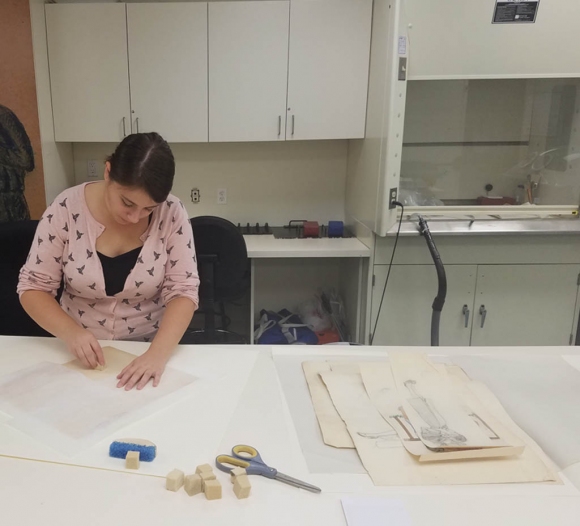I am writing this on a Wednesday, and if this were a normal Wednesday, I would be at Yeshiva University Museum (YUM) in the Center for Jewish History, in our basement work room, sewing (by hand). I think back to the 1926 robe de style that I had begun conserving, the binder on exhibition that will need re-rolling, and the everyday maintenance we do for the costumes and textiles in the Museum's collection.
Instead, I am sequestered at home in New Jersey, sewing something else -- masks.

We work in the basement; but we are also known as 'the textile ladies'. Under the expert leadership of June Burns Bové, we work with the costume and textile collection. We catalog, conserve and archivally pack and store any and all Museum objects containing thread or fiber. Other Center members are aware of our activity and presence, and if they come across objects in their respective collections they often ask Bonni-Dara Michaels, our Collections Curator, when we will be in, and they then gently knock on our door to ask advice, which is readily given. One maintenance worker at the Center knows us as the proprietors of the 'plastic people'; ie., our mannequins.
I have been working at YUM with the textile collections since 2005, when our award winning exhibition "A Perfect Fit" was first mounted. It had 125+ mannequins ... many of which took 5-6 hours or more to mount and properly prepare for exhibition. Since then, among the.many exhibitions we have contributed to were the Center's 10th Anniversary Show, in 2010; an exhibition featuring the many aspects of textiles in YUM's collection entitled "Uncommon Threads;" and the recent exhibit about the Kindertransport.

Uncommon Threads installation
I feel fortunate to work for an institution that values the role that textiles and costumes play in our lives, be they in everyday usage or in a ritualistic sense. Our objects tell stories, and what better way to understand history and culture than through clothing, something that we all wear on a daily basis? Some of our pieces are also ethnic in nature, or artistic in creation. And yes, some of them we have lovingly nicknamed as our work with them becomes a long, intimate affair.

Wedding dress of
Stella Rozanska Rentz
Designer: Hattie Carnegie
Gift of Tricia Kasner
One day we will be able to tell the remarkable story of our Hattie Carnegie wedding gown, or the art piece we call "Amulet Man." The pieces designed by those famous and not-so-famous, who worked in what was once known as 'the shmata industry.'. The tallis bag lovingly embroidered by someone, we may not know who, but whose work lives on and is both admired and preserved. Dresses worn to weddings and bnai' mitzvot. The bindallis worn, often by brides, in the Ottoman Empire.

"Warrior of God" Protective Amulet Costume 2
Artist: Michael Berkowitz
Gift of the artist
So, instead of the robe de style that I began repairing with thread known as 'hair silk' (because it is as fine as a strand of hair) I am home, sewing masks. Some are for health care workers, some are for family and friends, who knowing that I sew, have asked if I was making them. I've made upwards of 100+ by now, sitting at my Singer sewing machine, on which I have been sewing seemingly forever. Much to the consternation of my husband, I do have a fabric stash, and it has been now been put to a greater use.
But I miss our Wednesdays - the friendships and camaraderie that have formed. The NYT crossword puzzle we do at lunch. And I think of the objects that are awaiting being taken to storage, being repaired, catalogued and admired. We used to laugh that we had no idea what it was like outside until we left the Center at the end of the day, as our room is windowless. It saddens me to know that the Center is dark, and the streets of New York City empty. But I look forward to the day we can all safely return.

Comments
Barbara Fischer - April 28, 2020 9:04 pm
This was an interesting article about the work that goes into mounting costumes and textiles. I hope to visit this museum some day soon.
Gil - April 29, 2020 3:04 am
Very interesting. So real and true. Taking real life today and putting it in the perspectives of history of costumes. Thanks you!
Share Your Comments: